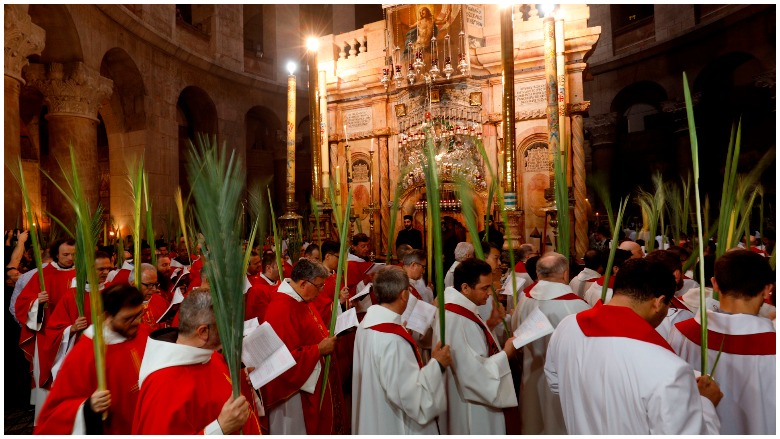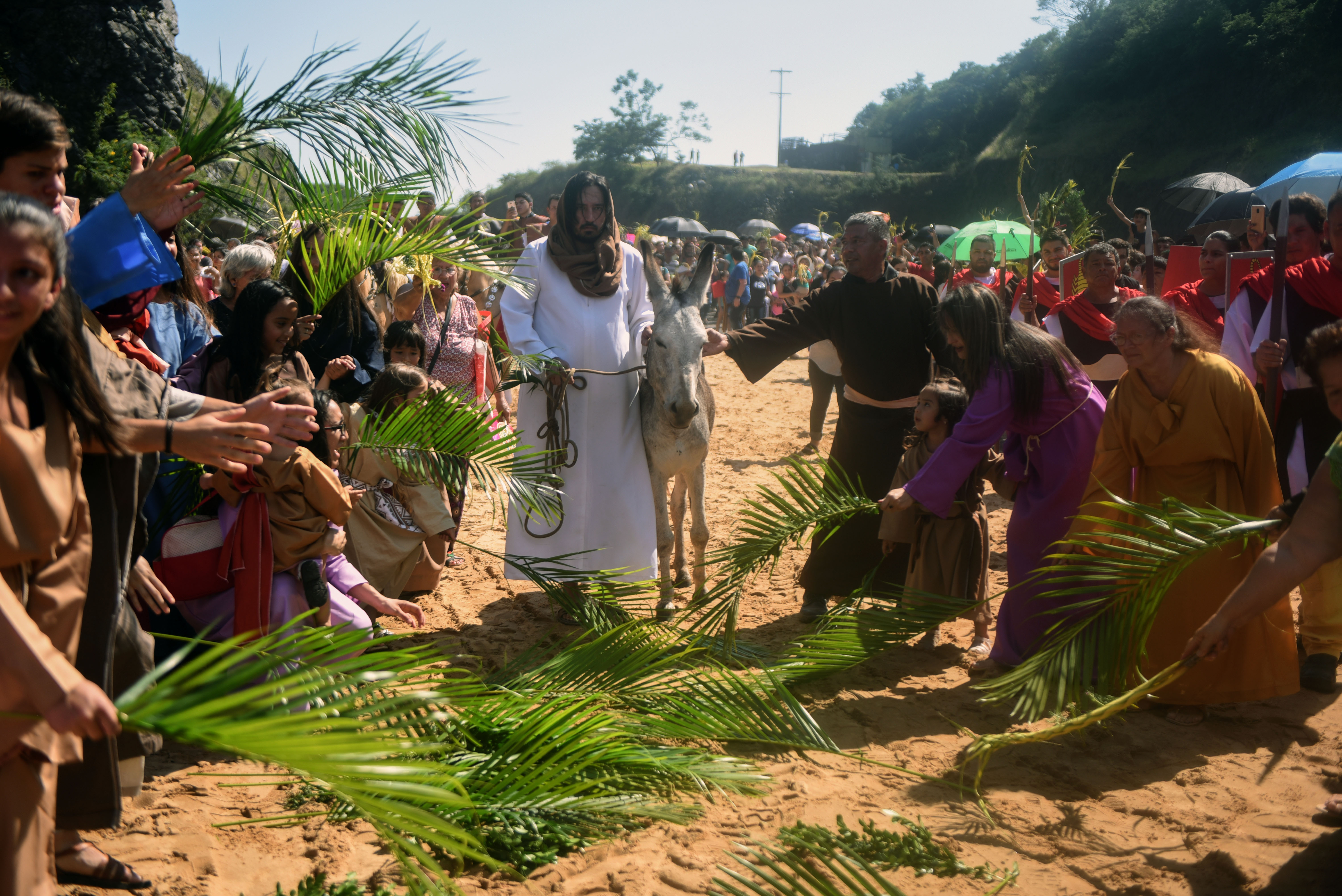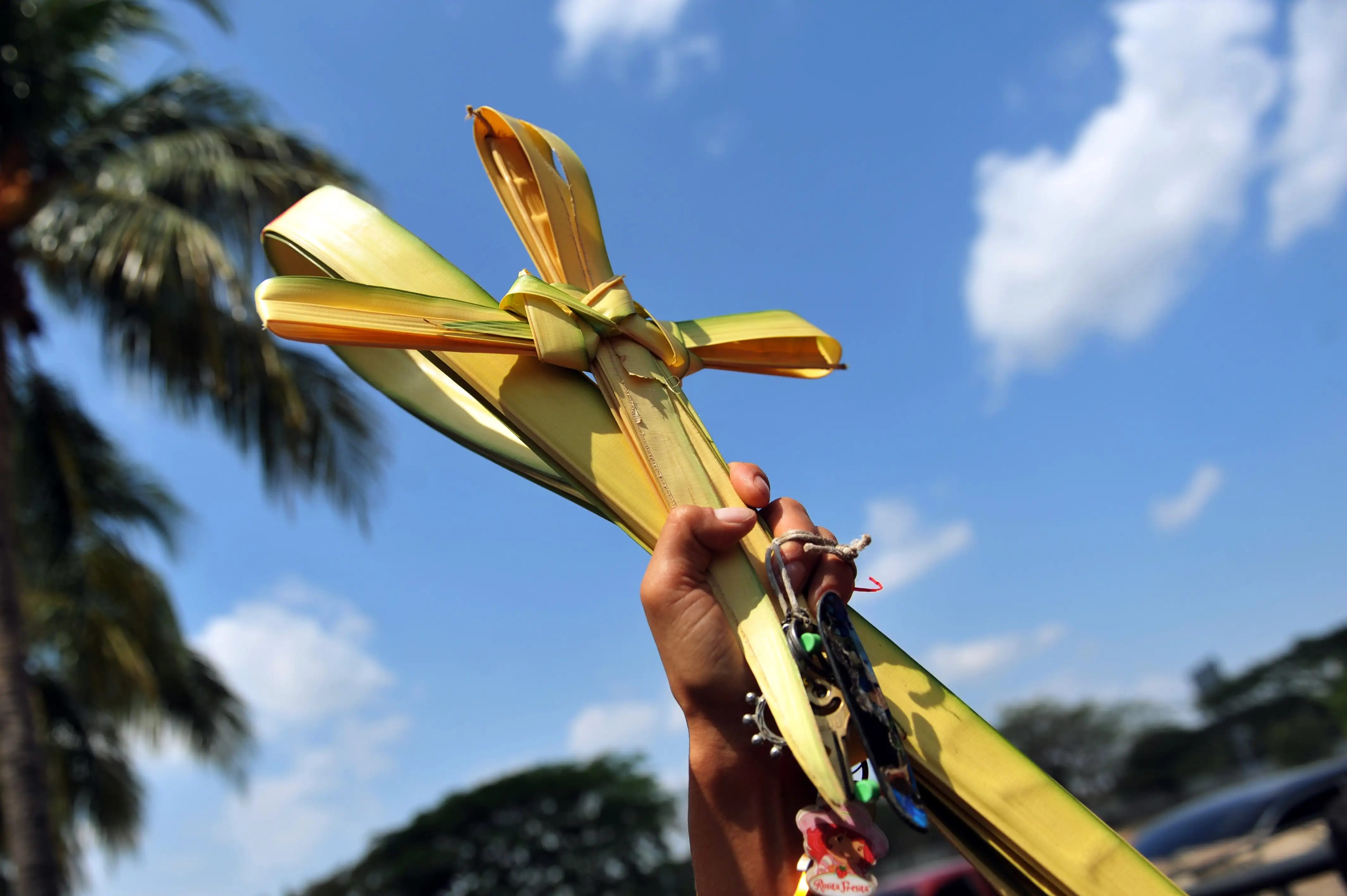
Palm Sunday is the beginning of Holy Week for Catholics and other Christians. It takes place one week before Easter, which is the most important celebration on the Christian liturgical calendar.
Palm Sunday marks the day Jesus Christ triumphantly entered Jerusalem. Crowds cheered for him and placed palms on the ground in front of Jesus as he rode into the city on the back of a donkey. Palms are traditionally viewed as symbols of victory and peace, as Catholic Online explains.
Here’s what you need to know:
The Palm Branches Signified the Crowd Recognized Jesus as the Messiah, According to the Catholic Tradition

Getty Catholic faithful take part in the reenactment of Jesus Christ’s entry into Jerusalem, during the Palm Sunday procession in Cerro Nemby, Paraguay on April 14, 2019.
Jesus visited Jerusalem to celebrate Passover with his family and friends. As the story is told in the Bible, Jesus instructed two of his disciples to retrieve a donkey that he would ride on as they entered the city. By riding a donkey, Jesus was fulfilling a prophecy, as explained in the Bible:
As they approached Jerusalem and came to Bethphage on the Mount of Olives, Jesus sent two disciples, saying to them, “Go to the village ahead of you, and at once you will find a donkey tied there, with her colt by her. Untie them and bring them to me. If anyone says anything to you, say that the Lord needs them, and he will send them right away.”
This took place to fulfill what was spoken through the prophet:
“Say to Daughter Zion,
‘See, your king comes to you,
gentle and riding on a donkey,
and on a colt, the foal of a donkey.'”The disciples went and did as Jesus had instructed them. They brought the donkey and the colt and placed their cloaks on them for Jesus to sit on. A very large crowd spread their cloaks on the road, while others cut branches from the trees and spread them on the road.
As Jesus entered Jerusalem, people in the crowd placed palm branches on the ground ahead of him. Bishop Robert J. Brennan of the Diocese of Columbus in Ohio explained to Heavy, “Palms were a sign of victory and triumph and were often thrown down before victorious generals and kings. The crowds did this on their own and indicates that they recognized Jesus as Messiah.”
The crowds also cheered Jesus’ arrival by shouting, “Hosanna to the Son of David! Blessed is he who comes in the name of the Lord!” The U.S. Conference of Catholic Bishops explains this signified the crowd “had come to believe and to have faith in Him as a prophet from God.”
The believers in Jerusalem that day may have expected Jesus to be the leader that could free them from Roman rule, as Learn Religions explained. But as Bishop Brennan detailed, “Jesus would reveal by His death that He was not the kind of earthly Messiah or king that they expected.”
Bishop Brennan also commented about whether Palm Sunday is considered a “happy” day in the Catholic tradition. He told Heavy, “Palm Sunday starts out glorious as we remember Christ’s triumphal entry into Jerusalem. However, it turns bitter as we read the Gospel story of His Passion and Death.”
The Palms Are Later Burned & Used for Next Year’s Ash Wednesday

Getty Palm Sunday marks the beginning of Holy Week and commemorates Christ’s triumphant entry into Jerusalem on the back of a donkey, welcomed by crowds waving palm branches, before his arrest, trial, crucifixion and resurrection.
In modern times, Catholics traditionally celebrate Palm Sunday with a procession at the beginning of mass. Members of the congregation are given palm branches before mass starts. Everyone carries the branches into the church to commemorate Jesus’ entry into Jerusalem. (Of course, these celebrations are much more muted amid the coronavirus pandemic with most churches continuing to stream masses online).
The palm branches are blessed and believers typically keep them as symbols of their faith. It’s common to fold the branches into the shape of the cross or to weave them together and use them as decoration. As the Catholic News Agency explains, the branches are later burned and the ashes are used during the next year’s Ash Wednesday.
Catholics are not permitted to just throw away palm branches that have been blessed by a priest. Believers are instructed to either return the branches to their local church or to burn and bury them. As the Nativity Catholic Church explained on its website, “This type of disposal honors their sacred purpose and returns them to the earth in a dignified way.”